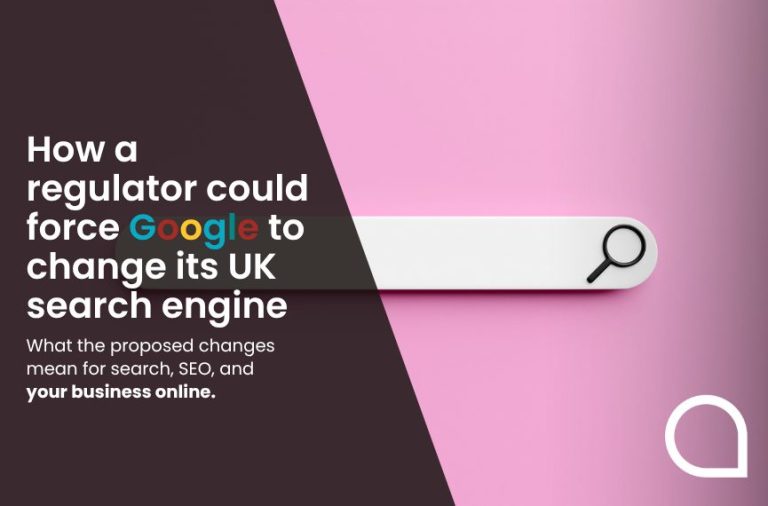
How can digital PR help my company grow?
Struggling to unlock the full potential of your business and kickstart growth? Public Relations (PR) could be the key. Often used to build a positive
Struggling to draw customers to your site? Maybe it’s time to channel your inner writer and whip up some compelling meta descriptions to increase your website’s traffic! An effective way to not only encourage more customers to click through to your content, but to also appease Google, taking the time to write effective meta descriptions is crucial to your website’s success.
If you’re still asking yourself ‘what is a meta description?’, then carry on reading as we explore the purpose of a meta description, the ideal meta description length and how these snippets of information can be used by search engines. Plus, once you’re ready to start creating your own meta descriptions, we have plenty of writing tips and tricks that will encourage your customers to pay your website a visit.
A meta description is an essential HTML element of every online page that is helpfully displayed just underneath the page title to provide the user with more information. The primary purpose of a meta description is to describe and sum up the content of the page to help the user easily find the exact information they’re searching for.
The secondary purpose of this ‘search snippet’ is to inform Google and other major search engines how the content within relates to various search queries. When a user submits a relevant search query, ‘search snippets’ from various websites will appear in a list format on a search engine result page (SERP) with Google prioritising the most relevant and authoritative domains first.
A meta description provides an incredibly useful insight into the content users can expect to find if they click through to a page. As a result, you should include a clear and compelling reason for the user to view your website content in the meta description. This reason will naturally vary depending on the type of content on the page, but it should be accurate to reduce the bounce rate, and it should feature at least one of your target keywords to ensure it’s relevant.
The most important thing to avoid when writing a meta description is adding in general information about your business that isn’t directly relevant to the content you’re trying to describe. You only have a limited number of characters to sum up the content, so filling this space with irrelevant information is likely to dissuade customers from clicking through to your content.
Ensuring the meta description is solely focused on the page content will also help to keep the bounce rate low because it provides users with an accurate idea of what they can expect when clicking through to the page. A good bounce rate is considered to be between 26-40%, so if some of your pages have much higher bounce rates than this, you should consider checking the content of your meta descriptions.
..
SEO (Search Engine Optimisation) refers to the process of improving a website’s visibility and search ranking. Meta descriptions were previously used as a search ranking signal by Google. However, Google hasn’t used meta descriptions to determine a page’s search position since 2004. Despite Google no longer using meta descriptions in this manner, they’re still an important component of any SEO strategy.
Most importantly, a well-written SEO meta description takes into account the user. As Google’s ultimate aim is to organise information from around the world and to make it both accessible and useful for their users, writing your meta descriptions with the user in mind should boost your click-through rates (CTRs).
There are several ways that you can make your meta descriptions more SEO-friendly and therefore more beneficial for the user. By considering the search intent of the user, including a range of keywords that are relevant to your content, and adding in an alluring CTA (call-to-action), you can create more effective meta descriptions.
First and foremost, meta descriptions should include a wide range of relevant keywords. If you have a beauty business, for example, and want to direct your customers towards a category page that features a host of different cosmetic products, you must first consider the range of keywords associated with that category. By way of illustrating, you may have a category page of ‘Lipsticks’. If a user is simply searching for ‘Lipsticks’, it’s likely that they’re searching for the different types of lipsticks that are available.
Within this category, you may sell liquid lipsticks, matte lipsticks, glossy lipsticks and satin lipsticks. The meta description should therefore include these various lipstick keywords as it highlights the considerable selection you have on offer and can inspire the user to explore your range. Check out the below example to see how you can weave these important keywords into an inviting meta description!
‘Looking for a new lippy? For a picture-perfect pout, shop our range of liquid lipsticks, matte lipsticks, glossy lipsticks and satin lipsticks in every shade.’
The key to tailoring meta descriptions to different types of content is to ensure you have successfully identified the user search intent. To classify content, intent can be split into several broad areas including transactional, informational, navigational and commercial intent. Informational intent, for example, typically refers to blog posts and guides where users are simply searching for guidance or an answer to a specific question.
Unlike meta descriptions that have a transactional intent and often feature phrases like ‘affordable prices’ and ‘big deals’ because they target users that want to complete an action or a purchase, informational content needs to demonstrate authority, reliability and accuracy. To illustrate this, we’ve created an example of an informational meta description below.
‘Struggling to select the right shade of statement lippy? Find out how you can discover the perfect shade of lipstick to complement your skin tone here.’
Alongside describing the content that the user can expect to find after clicking through to the page, the meta description should also feature wider information that customers might find important. For example, businesses that deliver products may want to add short phrases that highlight convenience and affordability on product or category pages, such as ‘free delivery in the UK’ or ‘fast and free delivery’.
Similarly, websites that offer services can also create meta descriptions with these strong CTAs. This includes phrases like ‘24/7 customer service’ and ‘call now for a free quote’. These short and snappy snippets can be easily appended onto the end of your meta descriptions to give the user another reason to view your content without using too many important characters.
‘Feel like a million dollars on those big occasions with a helping hand from our talented team of makeup artists. Call now to discuss your makeover requirements!’
Another way to ensure you’re writing meta descriptions that Google finds helpful for their users is to do your research. Try searching for keywords that you want to rank for and make a note of the pages that rank and their meta descriptions. Eventually, you’ll start to see a pattern emerge upon which you can base your own meta descriptions.
Before we explore whether duplicate meta descriptions have a negative affect on SEO, let’s first unpick what is meant by ‘duplicate meta descriptions’. A duplicate meta description refers to using the exact same text across multiple pages on the same website. This is a common occurrence for large eCommerce businesses that automatically create hundreds of listings with the same meta description.
While the likelihood of Google penalising you for duplicate meta descriptions is low, this doesn’t mean that they’re not harmful to your search rankings. Providing each meta description with a unique snippet of text will not only help your customers to find the right product or service for their purposes, but it’ll also encourage some products to rank higher than others. Duplicating meta descriptions is therefore considered a bad SEO practice.
Technically, there are no strict limits regarding meta description length. However, Google, the world’s most popular search engine, limits these snippets of information to around 155-160 characters, so ensuring your meta descriptions are roughly 160 characters should increase the likelihood of Google displaying them without replacing them with their own alternative.
While there are no set limits on how long a meta description should be, this does not mean that you should fill it with as many keywords as possible! If Google finds your meta description to be too long, it will automatically truncate it with an ellipses (…) to ensure it fits within the snippet display. Alternatively, Google may select a sentence from the page itself to use as a meta description if they believe it to be a better option based on the search enquiry.
Generally, it’s best to create a meta description that falls within Google’s ideal meta description character count (155-160 characters). However, meta descriptions around 140 characters can still easily sum up certain types of content, but when they’re too short, you’re missing a vital opportunity to encourage more customers to view your content.
If your meta descriptions are less than 120 characters you may want to consider adding some more information to them. From delivery times and prices to customer service details and vital keywords, there’s plenty of important information that can be added to bulk up your meta descriptions.
Yes, meta descriptions are still incredibly relevant! While Google doesn’t use meta descriptions to determine the search ranking on your content anymore, they still remain an important part of any SEO strategy. Most notably, they can dramatically increase your CTRs if they’ve been well written!
In recent years, Google has highlighted just how relevant these helpful descriptions can be by altering and rewriting meta descriptions themselves. Meta descriptions can be rewritten for several reasons; if they are of poor quality and fail to accurately summarise the content of the page, if the content is missing part of the search query, and if the search query isn’t in the meta description, but the content is still relevant.
Ultimately, Google’s algorithm will only rewrite a meta description to help their users. The search engine’s primary aim is to direct their users to the right content in order to provide them with accurate answers to their questions. However, if you write your meta descriptions with the user’s search intent in mind, Google is likely to leave your descriptions alone.
..
If you require more information or advice regarding meta descriptions and SEO strategies, then please don’t hesitate to get in touch with our expert marketing team at Aqueous Digital. With the ability to improve the SEO of online businesses in Manchester and Liverpool, our award-winning company specialises in both organic and paid search, as well as website content and reputation management for high-net-worth individuals.
At Aqueous Digital, we know that the online presence of your website is crucial to the success of your business which is why we offer a free website health check and consultation. To get in touch with a friendly and knowledgeable member of our specialist team, you can either contact us online using our online contact form, drop us an email at agency@aqueous-digital.co.uk, or give us a call on 0800 285 1424.
However you decide to get in touch, you can rest assured that our experienced team will be on hand to help send your online business soaring!
..
Content is King. What is content marketing?
Creating great content: How to write for SEO
How digital marketing has changed over the years
How video content can elevate your website
Top 20 Facts about Manchester You Never Knew
Aqueous Digital’s Ultimate Guide to the cost of SEO in the UK
Aqueous Digital’s Guide to the Top 501 SEO and Digital Marketing Terms
How video content can elevate your business
How long does SEO take to work?
What are the most important SEO ranking factors?

Struggling to unlock the full potential of your business and kickstart growth? Public Relations (PR) could be the key. Often used to build a positive

Weighing up whether your business should invest in marketing or public relations (PR)? As seasoned digital PR and marketing professionals, the expert team at Aqueous

Digital public relations (better known as just digital PR) is quickly becoming an essential instrument in the modern marketers’ toolkit. As Google’s algorithms evolve and

There’s something about machine-written content that just doesn’t sit right with us. And it’s not just the written word either. Take Coca Cola’s latest Christmas

The way people find information online is evolving, and quickly. Artificial intelligence (AI), whether that’s applied generatively through tools like ChatGPT or in response to

On October 10 2025, the UK’s Competition and Markets Authority (CMA) announced that Google had been granted strategic market status (SMS) in search services. Why